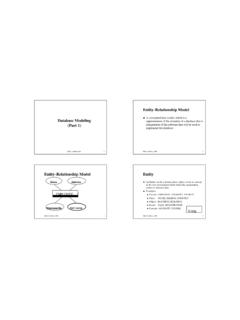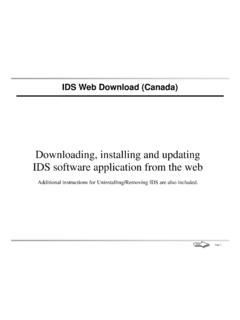Transcription of Chapter 4 Methods of Software Acquisition - peter …
1 BA4B2001 @ peter Lo 20071 Chapter 4 Methods of Software AcquisitionBA4B2001 @ peter Lo 20072 Evaluating Software Alternatives Examine Software alternatives and select an overall strategy for the proposed system to prepare for the transition to the systems design @ peter Lo 20073 Custom Developed Software Some businesses consider that their processing requirements are specific to their own organization and they have the application Software developed specifically. In-house Development Employing programmers and analysts and setting up an internal IT group. Contract an External Software The company could use the services of a computer bureau or Software house, especially if it is a small organization which couldn't afford a fulltime development team. The resultant Software is known as Custom-developedor Tailor-made Softwaresince it exactly fits the requirements of the organization, just as a tailor-made suit exactly fits the @ peter Lo 20074 Advantages of Custom Developed Software The advantages of this type of applications Software development is that the resultant program will exactly fulfill the processing @ peter Lo 20075 Disadvantages of Custom Developed Software Higher Cost Software DefectsBA4B2001 @ peter Lo 20076 Disadvantages of Custom Developed Software Higher Cost The cost of producing tailor-made Software is high, just as tailor-made clothing is expensive.
2 This is because the costs of developing the Software are entirely borne by the one organization instead of them being borne by many @ peter Lo 20077 Disadvantages of Custom Developed Software Software Defects It is very unusual for Software to be perfect when the programmers have finished. There is typically a period when the Software is first operated where faults, or bugs, become exposed and have to be corrected. This can often cause serious inconvenience to the end-user and, in terms of lost time and efficiency, increases the overall cost of the @ peter Lo 20078 Reasons for In-House Developing Companies choose in-house development to: Satisfy Unique Business Requirements Minimize Changes in Business Procedures and Policies Meet Constraints of Existing Systems Meet Existing Technology Develop Internal Resources and CapabilitiesBA4B2001 @ peter Lo 20079 Reasons for In-House Developing Satisfy Unique Business Requirements No commercially available Software package can meet their unique business requirements.
3 BA4B2001 @ peter Lo 200710 Reasons for In-House Developing Minimize Chances in Business Procedures and Policies While installing a new Software package almost always requires some degree of change in how a company does business If the installation of a purchased package will be too disruptive, then the organization might decide to develop its own Software instead. BA4B2001 @ peter Lo 200711 Reasons for In-House Developing Meet Constraints of Existing Systems Any new Software installed must work with existing systems. Ensure that the new system will interface with the old system. BA4B2001 @ peter Lo 200712 Reasons for In-House Developing Meet Constraints of Existing Technology Another reason to develop Software in-house is that the new system must work with existing hardware and legacy systemsBA4B2001 @ peter Lo 200713 Reasons for In-House Developing Develop Internal Resources and Capabilities Many firms feel that in-house IT resources and capabilities provide a competitive advantage because they can respond quickly when business problems or opportunities arise.
4 BA4B2001 @ peter Lo 200714 Purchasing a Software Package A commercially available Software package could satisfy system requirements. Lower Cost Less Time to Implement Proven Reliability and Performance Benchmarks Less Technical Development Staff Future Upgrades Proved by the Vendor Other Companies as ResourcesBA4B2001 @ peter Lo 200715 Reasons for Package Purchasing Lower Costs Because many companies use Software packages, Software vendors spread the development costs over many customers. BA4B2001 @ peter Lo 200716 Reasons for Package Purchasing Less Time to Implement When you purchase a package, it already has been designed, programmed, tested, and documented. BA4B2001 @ peter Lo 200717 Reasons for Package Purchasing Proven Reliability and Performance Benchmarks If the package has been on the market for any length of time, any major problems probably have already been detected and corrected by the vendor.
5 If the product is popular, it almost certainly has been rated and evaluated by independent reviewers. BA4B2001 @ peter Lo 200718 Reasons for Package Purchasing Less Technical Development Staff Companies that use commercial Software packages often are able to reduce the number of programmers and systems analysts on the IT staff. BA4B2001 @ peter Lo 200719 Reasons for Package Purchasing Future Upgrades Provided by the Vendor Software vendors regularly upgrade Software packages by adding improvements and enhancements to create a new version or release. BA4B2001 @ peter Lo 200720 Reasons for Package Purchasing Other Companies as Resources Using a commercial Software package means you can contact users in other companies to get their impressions and input about the Software package. BA4B2001 @ peter Lo 200721 Advantages of Packaged Software Lower Cost Less Software Defects Better Documentation Training Easily AvailableBA4B2001 @ peter Lo 200722 Advantages of Packaged Software Lower Cost The most obvious and important advantage is that packages are significantly cheaper to buy than custom-developed Software .
6 This is because package is sold to a large market and the development costs can be spread among a large number of @ peter Lo 200723 Advantages of Packaged Software Less Software Defects Given the large market to which packages are sold, most of the problems which commonly beset new Software have been ironed out prior to the introduction into the market place. It is good policy, however, to avoid pioneering by buying new Software . It is always better to purchase Software that has been available for some time and will be well tried and @ peter Lo 200724 Advantages of Packaged Software Better Documentation Given the scale of the applications package market, it is more feasible for the producers to provide good documentation to accompany the Software . Clearly, this will make the package easier to use, which will make it more attractive to the market and therefore easier to @ peter Lo 200725 Advantages of Packaged Software Training Easily Available The ease of use is also improved by the fact that it becomes viable for consultants and training organizations to offer training courses in using it.
7 BA4B2001 @ peter Lo 200726 Disadvantages of Packaged Software May not meet all requirements Less efficientBA4B2001 @ peter Lo 200727 Disadvantages of Packaged Software May not meet all requirements The facilities that are offered by a package are not as specific to a business as tailor-made Software and might not quite satisfy the processing requirements of the @ peter Lo 200728 Disadvantages of Packaged Software Less efficient Since the system is designed for more general purposes than the tailor-made Software , the design may be less efficient. For example, a user may have to go through some unnecessary steps in processing which cannot be @ peter Lo 200729 Customizing Software Packages Acquire a package that can be customized to meet the needs of an organization. Purchase a basic package that vendor will customized to suit your needs Negotiate directly with the Software vendor to make enhancements to meet your needs by paying extra charge Purchase the package and make your own modification.
8 BA4B2001 @ peter Lo 200730 ComparisonBA4B2001 @ peter Lo 200731 Other Software Alternatives Other possibilities include using an application service provider, outsourcing, and developing end-user applications. Application Services Providers Outsourcing User ApplicationBA4B2001 @ peter Lo 200732 Application Service Providers (ASP) An ASP delivers applications, or access to applications, by charging a usage or subscription fee. An ASP provides more than a license to use the Software ; it rents an operational package to the customer. The service that the ASP provides is called Application Hosting. BA4B2001 @ peter Lo 200733 Outsourcing Outsourcing is the use of outside companies called Service Providersto handle a portion of a company s IT workload on a temporary or long-term basis. Many firms outsource IT work as a way of controlling costs and dealing with rapid technological change.
9 BA4B2001 @ peter Lo 200734 User Applications User applications utilize standard business Software , such as Microsoft Office, which has been configured in a specific manner to enhance user productivity. For example, to help a sales respond rapidly to customer price requests, an IT support person can set up a form letter with links to a spreadsheet that calculates incentives and discounts. BA4B2001 @ peter Lo 200735 Selecting a Software AlternativeBA4B2001 @ peter Lo 200736 Steps in Evaluating and Purchasing Software Packages1) Evaluate the Information System Requirements Identify the Key Features of the system Estimate Volume and Future Growth Specify any Hardware Constraints Prepare a Request for Proposal or Quotation2) Identify Potential Software Vendors 3) Evaluate Software Package Alternatives 4) Make the Purchase 5) Install the Software Package BA4B2001 @ peter Lo 200737 Step 1A: Evaluate the Information System Requirements Based on your analysis of the system requirements, Identify the system s key features Estimate volume and future growth Specify any hardware constraints Prepare a request for proposal or quotationBA4B2001 @ peter Lo 200738 Step 1B.
10 Evaluate the Information System Requirements Identify The Key Features of The System Evaluating system requirements involved highlighting any critical features the system must have. BA4B2001 @ peter Lo 200739 Step 1C: Evaluate the Information System Requirements Estimate Volume and Future Growth Know the current volume of transactions and processing Forecast changes over a three-to-five-year period. BA4B2001 @ peter Lo 200740 Step 1D: Evaluate the Information System Requirements Specify any Hardware Constraints The Software must run properly on your current or proposed hardware platform. BA4B2001 @ peter Lo 200741 Step 1E: Evaluate the Information System Requirements Prepare a Request for Proposal or Quotation Prepare a Request for Proposal(RFP) or a Request for Quotation(RFQ) to obtain the information for making decision. Request for proposal (RFP) is a written list of features and specifications given to prospective vendors when not identified a specific product or package to use.












